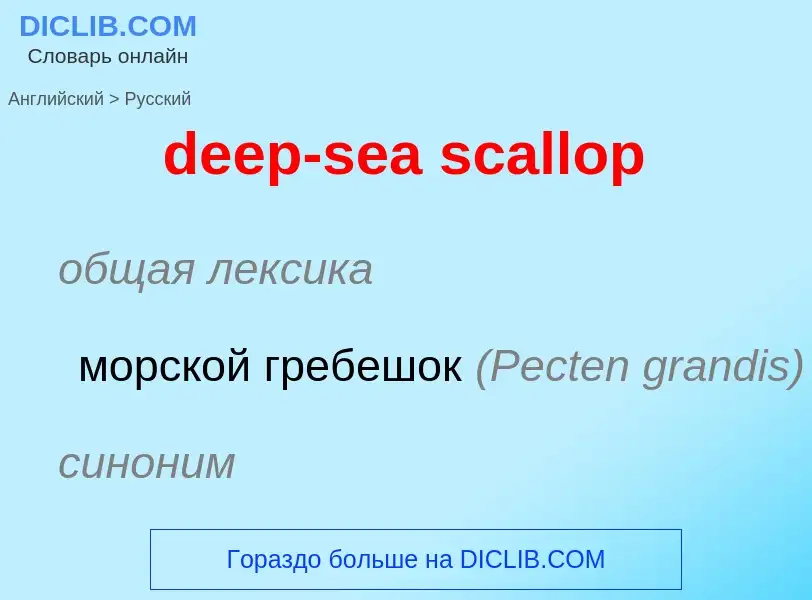Translation and analysis of words by artificial intelligence
On this page you can get a detailed analysis of a word or phrase, produced by the best artificial intelligence technology to date:
- how the word is used
- frequency of use
- it is used more often in oral or written speech
- word translation options
- usage examples (several phrases with translation)
- etymology
deep-sea scallop - translation to English
общая лексика
морской гребешок (Pecten grandis)
синоним
Смотрите также
Definition
2) Эгейское море
Wikipedia

Deep-sea fish are fish that live in the darkness below the sunlit surface waters, that is below the epipelagic or photic zone of the sea. The lanternfish is, by far, the most common deep-sea fish. Other deep sea fishes include the flashlight fish, cookiecutter shark, bristlemouths, anglerfish, viperfish, and some species of eelpout.
Only about 2% of known marine species inhabit the pelagic environment. This means that they live in the water column as opposed to the benthic organisms that live in or on the sea floor. Deep-sea organisms generally inhabit bathypelagic (1000–4000 m deep) and abyssopelagic (4000–6000 m deep) zones. However, characteristics of deep-sea organisms, such as bioluminescence can be seen in the mesopelagic (200–1000 m deep) zone as well. The mesopelagic zone is the disphotic zone, meaning light there is minimal but still measurable. The oxygen minimum layer exists somewhere between a depth of 700 m and 1000 m deep depending on the place in the ocean. This area is also where nutrients are most abundant. The bathypelagic and abyssopelagic zones are aphotic, meaning that no light penetrates this area of the ocean. These zones make up about 75% of the inhabitable ocean space.
The epipelagic zone (0–200 m) is the area where light penetrates the water and photosynthesis occurs. This is also known as the photic zone. Because this typically extends only a few hundred meters below the water, the deep sea, about 90% of the ocean volume, is in darkness. The deep sea is also an extremely hostile environment, with temperatures that rarely exceed 3 °C (37 °F) and fall as low as −1.8 °C (29 °F) (with the exception of hydrothermal vent ecosystems that can exceed 350 °C, or 662 °F), low oxygen levels, and pressures between 20 and 1000 atm (between 2 and 100 MPa).



![The rattail ''[[Coryphaenoides armatus]]'' (abyssal grenadier) on the Davidson Seamount at 2253 m depth. The rattail ''[[Coryphaenoides armatus]]'' (abyssal grenadier) on the Davidson Seamount at 2253 m depth.](https://commons.wikimedia.org/wiki/Special:FilePath/Coryphaenoides armatus 1.jpg?width=200)

![[[Gigantactis]] is a deep-sea fish with a [[dorsal fin]] whose first filament has become very long and is tipped with a bioluminescent [[photophore]] lure. [[Gigantactis]] is a deep-sea fish with a [[dorsal fin]] whose first filament has become very long and is tipped with a bioluminescent [[photophore]] lure.](https://commons.wikimedia.org/wiki/Special:FilePath/Gigantactis.jpg?width=200)
![An annotated diagram of the basic external features of an [[abyssal grenadier]] and standard length measurements. An annotated diagram of the basic external features of an [[abyssal grenadier]] and standard length measurements.](https://commons.wikimedia.org/wiki/Special:FilePath/Grenadier basic external features.png?width=200)
![[[Pelican eel]] [[Pelican eel]]](https://commons.wikimedia.org/wiki/Special:FilePath/PSM V23 D086 The deep sea fish eurypharynx pelecanoides.jpg?width=200)
![[[Bigeye tuna]] cruise the epipelagic zone at night and the mesopelagic zone during the day [[Bigeye tuna]] cruise the epipelagic zone at night and the mesopelagic zone during the day](https://commons.wikimedia.org/wiki/Special:FilePath/Thobe u0.gif?width=200)



![The [[pelican eel]] uses its large mouth like a net by opening its jaws and swimming towards prey. It has a luminescent organ at the tip of its tail to attract prey. The [[pelican eel]] uses its large mouth like a net by opening its jaws and swimming towards prey. It has a luminescent organ at the tip of its tail to attract prey.](https://commons.wikimedia.org/wiki/Special:FilePath/Eurypharynx pelecanoides.jpg?width=200)

![Female ''[[Haplophryne mollis]]'' anglerfish trailing attached males which have atrophied into a pair of gonads, for use when the female is ready to spawn. Female ''[[Haplophryne mollis]]'' anglerfish trailing attached males which have atrophied into a pair of gonads, for use when the female is ready to spawn.](https://commons.wikimedia.org/wiki/Special:FilePath/Hamol u0.gif?width=200)

![[[Scallop dredge]] catch}} [[Scallop dredge]] catch}}](https://commons.wikimedia.org/wiki/Special:FilePath/Scallop dredge catch.jpg?width=200)

